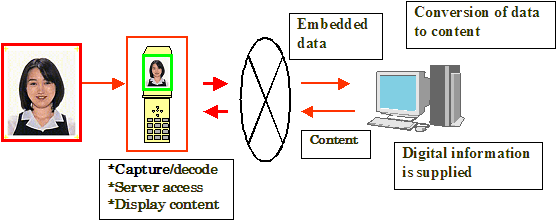Archived content
NOTE: this is an archived page and the content is likely to be out of date.
Fujitsu Develops World's First Technology That Embeds Data Invisibly in Print Images
Fujitsu Laboratories Ltd.
Tokyo , June 30, 2004
Fujitsu Laboratories Ltd. today announced the development of the world's first technology that embeds 12-digit numerical data(1) in printed color images in a way invisible to the human eye. This new technology makes it possible to embed data, such as ID codes to convert URLs or telephone numbers, into color images for magazines or advertisements without interfering with the printed design. Utilizing this technology with mobile phones or PDAs enables easy Internet access and phone calling. This technology was developed to provide more natural interfaces using mobile phones or PDAs, to customers offering new services such as linking printed images to the Internet.
Background
As mobile phones that can read QR codes(2) and barcodes(3) are becoming more widespread in Japan, services involving Internet connection using QR codes or barcodes are being launched. However, an issue to be resolved was that because QR codes or barcodes consist of white and black lines or dots geometrically aligned and are meant to be read by machines, they conveyed no meaning to people and interfered with printed designs. Given this, needs have grown for technology capable of embedding data equivalent to that of barcodes, without interfering with image designs that hold meaning to people.
Technological Challenges
Conventionally, digital watermarking technology was used to embed data into images. However, deterioration of image quality was unavoidable in order to extract data steadily, due to the fact that it is difficult to embed data into high-quality print images using digital watermarking. Furthermore, while high-speed processing capabilities are essential in view of user convenience, another issue was that extracting embedded data by digital watermarking required significant computation and time.
Fujitsu's New Technology
The newly developed technology is a type of technology known as steganography, consisting of an encoding technology that embeds data into color print images and a decoding technology that quickly and reliably reads embedded data in image data captured by cameras or scanners. Key features of this technology are:
1. Encoding technology that enables data embedding invisible to the human eye
This technology embeds data by leveraging characteristics of the human eye, which has variances in sensitivity to color and size. This makes it possible to avoid degradation in image quality, which occurs when digital watermarking is used. At the same time, even 12-digit numerical data can be embedded into images as small as 1 square centimeter. Furthermore, data can be embedded into images shot by digital cameras, and images with embedded data can be easily printed at home on general personal-use color printers.
2. Decoding technology that actualizes high-speed detection capabilities
This technology focuses on ease at which embedded data can be detected from image data, by encoding data which has been embedded through modulation of image density. Camera-equipped mobile devices can decode 12 digits of numerical data in less than one second(4) by using only internal processing.
Results
The new technology offers applications such as the following:
- Easy access to restaurant/store information featured in magazines
- Easy access to ringtones embedded in music CD jackets
- Making phone calls easily by detecting encoded phone numbers embedded in photographs on business cards
A wide variety of potential applications using printed images with embedded data can be anticipated, including sales promotions and new card games, etc.
Future Developments
Fujitsu will continue to explore ways to enable a more user-friendly interface such as by reducing required user operation steps, in order to accelerate adoption of this technology in mobile phones and other mobile devices. Fujitsu will pursue collaborations with mobile phone carriers, printing machinery manufacturers, and content providers and will promote solutions targeting the consumer and business markets.
 World's First Technology That Embeds Data Invisibly in Color Print Images
World's First Technology That Embeds Data Invisibly in Color Print Images
About Fujitsu Laboratories Ltd.
Founded in 1968 as a wholly owned subsidiary of Fujitsu Limited, Fujitsu Laboratories Limited is one of the premier research centers in the world. With a global network of laboratories in Japan, China, the United States and Europe, the organization conducts a wide range of basic and applied research in the areas of Multimedia, Personal Systems, Networks, Peripherals, Advanced Materials and Electronic Devices.
For more information, please see: http://www.labs.fujitsu.com/en/
Press Contacts
Public & Investor Relations
Inquiries
Company:Fujitsu Limited
Technical Contacts
Peripheral Systems Laboratories
I/O Systems Lab.
 E-mail: stegano@ml.labs.fujitsu.com
E-mail: stegano@ml.labs.fujitsu.com
Company:Fujitsu Laboratories Ltd.
All product names and company names mentioned herein are the trademarks or registered trademarks of their respective firms.
Date: 30 June, 2004
City: Tokyo
Company:
Fujitsu Laboratories Ltd.,
,
,
,
,
![]() E-mail: stegano@ml.labs.fujitsu.com
E-mail: stegano@ml.labs.fujitsu.com